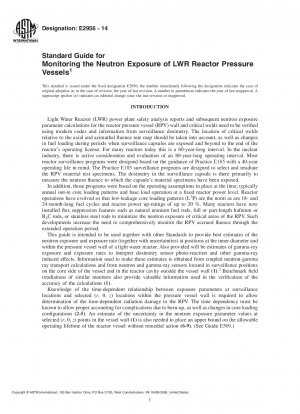ASTM E2956-14
Standard Guide for Monitoring the Neutron Exposure of LWR Reactor Pressure Vessels
- Standard No.
- ASTM E2956-14
- Release Date
- 2014
- Published By
- American Society for Testing and Materials (ASTM)
- Status
- Replace By
- ASTM E2956-21
- Latest
- ASTM E2956-23
- Scope
4.1 Regulatory Requirements—The USA Code of Federal Regulations (10CFR Part 50, Appendix H) requires the implementation of a reactor vessel materials surveillance program for all operating LWRs. Other countries have similar regulations. The purpose of the program is to (1) monitor changes in the fracture toughness properties of ferritic materials in the reactor vessel beltline region resulting from exposure to neutron irradiation and the thermal environment, and (2) make use of the data obtained from surveillance programs to determine the conditions under which the vessel can be operated with adequate margins of safety throughout its service life. Practice E185, derived mechanical property data, and (r, θ, z) physics-dosimetry data (derived from the calculations and reactor cavity and surveillance capsule measurements (1) using physics-dosimetry standards) can be used together with information in Guide E900 and Refs. 4, 10-17 to provide a relation between property degradation and neutron exposure, commonly called a “trend curve.” To obtain this trend curve at all points in the pressure vessel wall requires that the selected trend curve be used together with the appropriate (r, θ, z) neutron field information derived by use of this guide to accomplish the necessary interpolations and extrapolations in space and time.
4.2 Neutron Field Characterization—The tasks required to satisfy the second part of the objective of 4.1 are complex and are summarized in Practice E853. In doing this, it is necessary to describe the neutron field at selected (r, θ, z) points within the pressure vessel wall. The description can be either time dependent or time averaged over the reactor service period of interest. This description can best be obtained by combining neutron transport calculations with plant measurements such as reactor cavity (ex-vessel) and surveillance capsule or RPV cladding (in-vessel) measurements, benchmark irradiations of dosimeter sensor materials, and knowledge of the spatial core power distribution, including the time dependence. Because core power distributions change with time, reactor cavity or surveillance capsule measurements obtained early in plant life may not be representative of long-term reactor operation. Therefore, a simple normalization of neutron transport calculations to dosimetry data from a given capsule is unlikely to give a satisfactory solution to the problem over the full reactor lifetime. Guide E482 and Guide E944 provide detailed information related to the characterization of the neutron field for BWR and PWR power plants.
4.3 Fracture Mechanics Analysis—Currently, operating limitations for normal heat up and cool down transients imposed on the reactor pressure vessel are based on the fracture mechanics techniques outlined in the ASME Boiler and Pressure Vessel Code. This code requires the assumption of the presence of a surface flaw of depth equal to one fourth of the pressure vessel thickness. In addition, the fracture mechanics analysis of accident-induced transients (Pressurized Thermal Shock, (PTS)) may involve evaluating the effect of flaws of varying depth within......
ASTM E2956-14 Referenced Document
- ASTM E1005 Standard Test Method for Application and Analysis of Radiometric Monitors for Reactor Vessel Surveillance, E 706(IIIA)
- ASTM E1018 Standard Guide for Application of ASTM Evaluated Cross Section Data File, Matrix E 706 (IIB)
- ASTM E170 Standard Terminology Relating to Radiation Measurements and Dosimetry
- ASTM E185 Standard Practice for Conducting Surveillance Tests for Light-Water Cooled Nuclear Power Reactor Vessels, E706 (IF)
- ASTM E2005 Standard Guide for Benchmark Testing of Reactor Dosimetry in Standard and Reference Neutron Fields
- ASTM E2006 Standard Guide for Benchmark Testing of Light Water Reactor Calculations
- ASTM E2215 Standard Practice for Evaluation of Surveillance Capsules from Light-Water Moderated Nuclear Power Reactor Vessels
- ASTM E482 Standard Guide for Application of Neutron Transport Methods for Reactor Vessel Surveillance, E706 (IID)
- ASTM E509 Standard Guide for In-Service Annealing of Light-Water Cooled Nuclear Reactor Vessels
- ASTM E693 Standard Practice for Characterizing Neutron Exposures in Iron and Low Alloy Steels in Terms of Displacements Per Atom (DPA), E706(ID)
- ASTM E844 Standard Guide for Sensor Set Design and Irradiation for Reactor Surveillance, E 706(IIC)
- ASTM E853 Standard Practice for Analysis and Interpretation of Light-Water Reactor Surveillance Results, E706(IA)
- ASTM E900 Standard Guide for Predicting Neutron Radiation Damage to Reactor Vessel Materials, E 706 (IIF)
- ASTM E944 Standard Guide for Application of Neutron Spectrum Adjustment Methods in Reactor Surveillance, (IIA)
ASTM E2956-14 history
- 2023 ASTM E2956-23 Standard Guide for Monitoring the Neutron Exposure of LWR Reactor Pressure Vessels
- 2021 ASTM E2956-21 Standard Guide for Monitoring the Neutron Exposure of LWR Reactor Pressure Vessels
- 2014 ASTM E2956-14 Standard Guide for Monitoring the Neutron Exposure of LWR Reactor Pressure Vessels

Copyright ©2024 All Rights Reserved